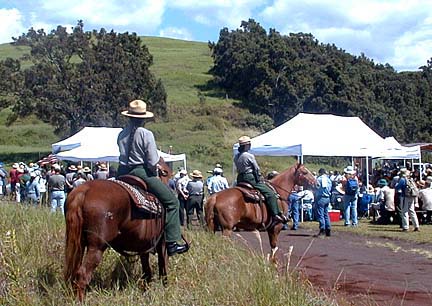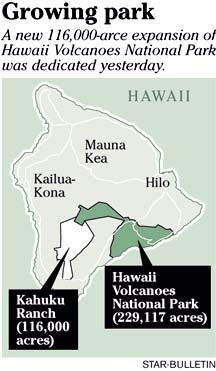

|
Big Island land
avoids development
The race is on to protect the
remaining Kahuku Ranch land
KAHUKU, Hawaii >> While Hawaii Volcanoes National Park held ceremonies to dedicate its new 116,000-acre Kahuku expansion yesterday, federal and private officials announced plans to protect thousands of additional acres from development.
 |
U.S. Sen. Daniel Inouye announced yesterday that he and U.S. Rep. Ed Case will begin efforts to acquire the remainder of the former Kahuku Ranch, about 1,500 acres below the highway with historic ranch buildings from the 1870s and three volcanic pit craters.
"We are in a race to preserve and protect the special places of Hawaii," Inouye said.
Meanwhile, the Nature Conservancy announced it had sold a permanent conservation easement on 2,240 acres of its land adjoining Kahuku to the U.S. Forest Service for $950,000. The money, from the federal Forest Legacy program, helps repay the conservancy for purchasing the land, while the easement means that neither the conservancy nor any subsequent owner can develop the land.
Last year, the conservancy sold its first Forest Legacy easement in the area, preserving 1,800 acres. Discussions are under way to sell an easement to the Forest Service on the conservancy's final 4,021-acre parcel in the area, said spokesman Grady Timmons.
All of the lands adjoin 25,000 acres of state forest that are protected by conservation designation.
"There's a growing contiguous region of (protected) forest," Timmons said. "One of the things that hurts forests is when they get fragmented."
About 600 people turned out for the Kahuku ceremony yesterday, a rare chance for the public to see the area, which is usually closed because of ranching operations that will continue there for another five years.
Cattle are needed to eat and control non-native grasses, said park biologist Tim Tunison. Pasture lands will gradually be planted with a variety of native trees and shrubs, restoring native forest, he said.
But a small area dedicated to ranching might be permanently preserved as a public demonstration of the cultural history of the area, he said.